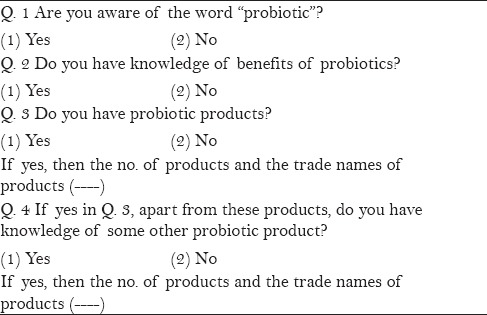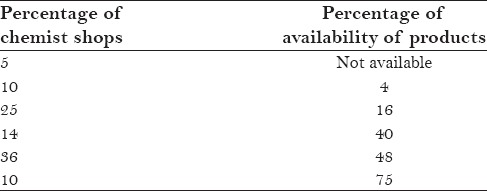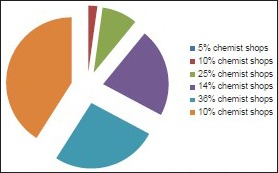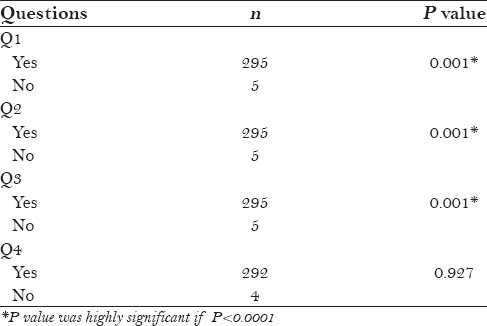Abstract
Context:
Probiotics are living microorganisms, principally bacteria, that are safe for human consumption and, when ingested in sufficient quantities, have beneficial effects on human health, beyond basic nutrition. However, in India people are not aware of their benefits and availability.
Aims:
To find status of probiotics in India and to assess the awareness regarding probiotics among chemists in New Delhi, India.
Settings and Design:
A cross-sectional survey was conducted among 300 chemist shops in different areas of New Delhi, India.
Materials and Methods:
Data were collected through a structured questionnaire, which was responded by the chemist in the course of a telephonic interview. The questionnaire addressed on the availability of probiotic products at their chemist shop.
Statistical Analysis Used:
The data so gathered were subjected for descriptive analysis using t test.
Results:
As per availability of probiotic products, total of 25 probiotic products were available at different chemist shops. None of the chemist shop had all the 25 products available. 10% shops had 75% products available and there were 5% such shops which didn’t have any of the products available.
Conclusion:
Efforts should be made to increase the awareness among chemists about the probiotic products.
Keywords: Chemists, lactobacillus, New Delhi: Telephonic interview, nutrition, probiotic, probiotic products
INTRODUCTION
Probiotics are living microorganisms, principally bacteria, that are safe for human consumption and, when ingested in sufficient quantities, have beneficial effects on human health, beyond basic nutrition. The establishment of standards and guidelines constitutes an essential step in the acceptance of probiotics as legitimate health-related products. To be called a probiotic, a bacterial strain must be fully characterized.[1] An ideal probiotic preparation should have the following characteristics:
High cell viability, and thus, they must be resistant to low pH and acids
Ability to persist in the intestine even if the probiotic strain cannot colonize the gut
Adhesion to the gut epithelium to cancel the flushing effects of peristalsis
They should be able to interact to send signals to the immune cells associated with the gut
They should be of human origin
Should be non-pathogenic
Resistance to processing
Must have the capacity to influence local metabolic activity.[2]
In addition, both in vitro and in vivo studies must be conducted to demonstrate the mechanism of action of the probiotic, to allow prediction of its scope of applicability, and to find its potential side effects. The Food and Agriculture Organization (FAO) and the World Health Organization (WHO) have recommended that probiotic bacterial strains be characterized by their spectrum of resistance to antibiotics, their metabolic and hemolytic activities, their capacity to produce toxins, their infectious power in immunosuppressed animal models, and their side effects in humans.[3] Probiotics that have been so characterized are then submitted to randomized clinical studies. The results of such studies should demonstrate an improvement in participants’ health and quality of life.[1]
The aim of our study was to find the status of probiotics in India and to assess the awareness regarding probiotics among chemists in New Delhi, India.
Strains of bacteria used as probiotics
Microorganisms that are considered to be probiotics mainly belong to the genera Lactobacillus and Bifidobacterium.[4] Lactobacilli and bifidobacteria are “friendly” bacteria, which means that they normally occur in the human gastrointestinal and genitourinary tracts and thus play important roles in promoting overall health.[5]
Lactobacilli are known to play an important role in the maintenance of human health by stimulating the natural immunity and contributing to the balance of microflora, mainly through competitive exclusion and antimicrobial activity against pathogenic bacteria.[6] Several species of obligately homofermentative, facultatively heterofermentative, and obligately heterofermentative lactobacilli have been found in the oral cavity, with Lactobacillus gasseri, Lactobacillus salivarius, Lactobacillus plantarum, Lactobacillus rhamnosus, and Lactobacillus fermentum being the most prevalent.[7]
Lactobacilli are widely used for the manufacture of fermented foodstuffs and, as such, have been consumed for centuries. During recent decades, lactobacilli have gained importance as probiotics, i.e. “live microorganisms which when administered confer a health benefit on the host.” Consumption of products containing probiotic lactobacilli has been shown to reduce caries risk and oral carriage of mutans streptococci.[8]
L. rhamnosus strain GG (LGG) was the first probiotic to have received the most clinical attention to date. It was discovered in 1985 by developing a list of ideal qualities for probiotics. LGG has been found to have beneficial effects on intestinal immunity. It increases the number of IgA and other immunoglobulin secreting cells in the intestinal mucosa, stimulates the local release of interferons, and facilitates antigen transport to underlying lymphoid cells, which serves to increase antigen uptake in Peyer's patches.[2]
In order to assess whether naturally occurring oral lactobacilli have probiotic properties, lactobacilli were isolated from the saliva and plaque of children and adolescents, with or without caries lesions. Twenty-three Lactobacillus spp. completely inhibited the growth of all mutans streptococci tested. Species with maximum interference capacity against mutans streptococci included Lactobacillus paracasei, L. plantarum, and L. rhamnosus.[9]
Bifidobacteria produce antimicrobial substances that are effective against many harmful gram-positive and gram-negative bacteria.[10] In fact, some species of bifidobacteria (including Bifidobacterium infantis, Bifidobacterium breve, and Bifidobacterium longum) bind to the intestinal mucosa and prevent attachment of pathogenic coliform bacteria.[5] In the gut microflora of newborn, breastfed children, bifidobacteria represent one of the predominant groups of intestinal bacteria.[11]
MATERIALS AND METHODS
A cross-sectional survey was conducted on 300 chemist shops in different areas of New Delhi, India in the month of February 2014. Data were collected through a structured questionnaire [Table 1] to which the chemists responded in the course of a telephonic interview, and informed consent was taken from all the study participants. Ethical clearance was obtained from the institutional ethical committee before the commencement of the study. Random convenient sampling method was used for the selection of study population. A pilot study was conducted on 30 chemists; their doubts related to the questions were analyzed and then, the questionnaire was modified accordingly. Reliability of the questionnaire was determined by using Cronbach's alpha coefficient test value degree 0.72. The analysis was performed at 95% confidence interval. The questionnaire addressed the availability of probiotic products at the chemist shops. The data so gathered were subjected to descriptive analysis. Around 100 chemist shops were reassessed for probiotic product availability to assess the inter-observer agreement (Cohen's kappa), and it was found to be substantial (kappa = 0.65).
Table 1.
Questionnaire used in the telephonic survey of chemists in New Delhi, India

RESULTS
Regarding availability, a total of 25 probiotic products were available at different chemist shops. None of the chemist shops had all the 25 products available; 10% chemist shops had 75% of the products available, 36% had 48% availability, 14% had 40% availability, 25% had 16% availability, 10% had 4% availability, and 5% of the chemist shops did not have any of the products available [Table 2, Graph 1]. Of the 300 medical shops, 4% chemists were not aware of probiotic products and 16% were only aware of sporolac. P value of the questionnaire filled by conducting a telephonic survey of the chemists of New Delhi, India was significant for questions 1-3 and not significant for question 4 [Table 3]. The availability of probiotic products in the various chemist shops showed a highly significant P value with P = 0.0000 [Table 4]. A list of the probiotic products available at the chemist shops in New Delhi, India showing the status of availability of probiotic products in India is given in Table 5.
Table 2.
Percentage of availability of probiotic products in the chemist shops at New Delhi

Graph 1.

Percentage of availability of probiotic products in the chemist shops at New Delhi, India
Table 3.
P values of questions from the questionnaire used in telephonic survey of the chemists from New Delhi, India

Table 4.
P value for the availability of probiotic products in various chemist shops

Table 5.
List of probiotic products available at chemist shops in New Delhi, India

DISCUSSION
Probiotics are defined as live microorganisms which when administered in adequate amounts confer a health benefit for the host.[12] They have been used to improve gastrointestinal health and their popularity has prompted increased interest for their role in promotion of oral health also.[13]
Ingestion of probiotics in any form, like in foodstuffs (cheese, yogurt, fermented milk, fruit juice, or chewing gum) or as a constituent of tablets and capsules, has been shown to afford a health promoting effect on oral tissues, such as reducing the incidence of dental caries, improved management of periodontitis, abridged halitosis and oral candidal infections.[14]
The present study revealed inadequate knowledge and awareness about probiotic products among the chemists. To our knowledge, this is the first study conducted on the different probiotic products available in the market. Literature search showed that in India, Sporolac, Saccharomyces boulardii, and yogurt (L. bulgaricus + L. thermophilus) are the most common ones used. Sporolac is manufactured using sporolactobacilli. Lactobacillus solution is an example of a probiotic that is usually given to pediatric patients. The latest and recent addition to the list of probiotics in India consists of genetically modified Bacillus mesentericus which acts as an alternative to B-complex capsules. Only sporulating lactobacilli are used with some of the antibiotic preparations.[15]
Potential benefits of probiotics are as follows: They have traditionally been used for the prevention of colon cancer, lowering cholesterol, lowering the blood pressure, managing lactose intolerance and Helicobacter pylori, improving the immune function, preventing infections and antibiotic-associated diarrhea, reducing inflammation, improving the mineral absorption, preventing harmful bacterial growth under stress, irritable bowel syndrome, and colitis, and managing urogenital health.[16]
Safety aspects of probiotic strains
Although probiotics can affect the most important caries pathogens, lactobacilli may be correlated with caries development. Some strains of Lactobacillus spp., together with Streptococcus mutans, play a key role in the development of dental caries. The production of organic acids from dietary carbohydrates is also a main factor in dental caries progression Studies addressing sugar fermentation have shown a strain-dependent pH drop and the decrease was the fastest with glucose for all tested strains, thus highlighting the acidogenic potential of probiotics. Due to the diversity of in vitro results, clear conclusions about which probiotics may add benefit to the oral cavity cannot be made. Further large-scale, multicenter clinical investigations are required to support the true effectiveness of probiotics in the prevention of oral and dental diseases. It has been also observed that caries-free subjects are colonized by lactobacilli that possess a significantly increased potential to suppress the growth of mutans streptococci, compared with caries active or arrested subjects.[17] Finally, it can be concluded that the effect of lactobacilli on caries prevention seems favorable with proper selection of probiotic strains. Furthermore, it should be mentioned that orally lactobacillus species are well tolerated by almost everyone. Flatulence or gas is the most common side effect of lactobacilli supplementation. It is usually very mild and goes away after 2 or 4 days. Immunocompromised people should be careful with the probiotics use as there have been reports of them entering the blood stream (sepsis) in these individuals.[4]
The FAO/WHO developed Operating Standards in 2002, which gave guidelines for all companies producing probiotic products.
These guidelines include the following:
Implementation of guidelines for use of probiotics
Phase I, II, and III clinical trials to prove the health benefits that are as good as or better than standard prevention or treatments for a particular condition or disease
Good manufacturing practice and production of high-quality products
Studies to identify the mechanism of action in vivo
Informative/precise labeling
Development of probiotic organisms that can carry vaccines to hosts and/or antiviral probiotics
Expansion of proven strains that are beneficial in the oral cavity, nasopharynx, respiratory tract, stomach, vagina, bladder, and skin, as well as for cancer, allergies, and recovery from surgery/injury.[18]
Limitations
Our study had quite a small sample size, akin to the pilot study, which may not reflect the authentic picture of the whole country. Hence, further studies with a larger sample size, standardized questionnaire, and inclusion of more criteria are required to be conducted nationwide to determine the standard that exists, which can bring out the real picture and point out the needs to be fulfilled.
CONCLUSION
Probiotics are emerging as a fascinating field in health. Thus, efforts should be made to increase awareness among the chemists to encourage the implementation of the concept, “probiotic rather than medicine.”
Footnotes
Source of Support: Nil
Conflict of Interest: None declared.
REFERENCES
- 1.Bonifait L, Chandad F, Grenier D. Probiotics for oral health: Myth or reality? J Can Dent Assoc. 2009;75:585–90. [PubMed] [Google Scholar]
- 2.Gupta V, Garg R. Probiotics. Indian J Med Microbiol. 2009;27:202–9. doi: 10.4103/0255-0857.53201. [DOI] [PubMed] [Google Scholar]
- 3.Reid G, Jass J, Sebulsky MT, McCormick JK. Potential uses of probiotics in clinical practice. Clin Microbiol Rev. 2003;16:658–72. doi: 10.1128/CMR.16.4.658-672.2003. [DOI] [PMC free article] [PubMed] [Google Scholar]
- 4.Tahmourespour A. Probiotics and the reduction of dental caries risk. In: Li M, editor. Contemporary Approach to Dental Caries. 1st ed. China: In Tech; 2012. pp. 271–88. [Google Scholar]
- 5.Bruno G. Knoxville, Tennessee: Huntington College of Health Sciences; 2009. Smart Supplementation: Probiotics; pp. 1–5. [Google Scholar]
- 6.McFarland LV. Normal flora: Diversity and functions. Microb Ecol Health Dis. 2000;12:193–207. [Google Scholar]
- 7.Ahrné S, Nobaek S, Jeppsson B, Adlerberth I, Wold AE, Molin G. The normal Lactobacillus flora of healthy human rectal and oral mucosa. J Appl Microbiol. 1998;85:88–94. doi: 10.1046/j.1365-2672.1998.00480.x. [DOI] [PubMed] [Google Scholar]
- 8.Kõll P, Mändar R, Marcotte H, Leibur E, Mikelsaar M, Hammarström L. Characterization of oral lactobacilli as potential probiotics for oral health. Oral Microbiol Immunol. 2008;23:139–47. doi: 10.1111/j.1399-302X.2007.00402.x. [DOI] [PubMed] [Google Scholar]
- 9.Simark-Mattsson C, Emilson CG, Håkansson EG, Jacobsson C, Roos K, Holm S. Lactobacillus-mediated interference of mutans streptococci in caries-free vs. caries-active subjects. Eur J Oral Sci. 2007;115:308–14. doi: 10.1111/j.1600-0722.2007.00458.x. [DOI] [PubMed] [Google Scholar]
- 10.Liévin V, Peiffer I, Hudault S, Rochat F, Brassart D, Neeser JR, et al. Bifidobacterium strains from resident infant human gastrointestinal microflora exert antimicrobial activity. Gut. 2000;47:646–52. doi: 10.1136/gut.47.5.646. [DOI] [PMC free article] [PubMed] [Google Scholar]
- 11.Caglar E, Kargul B, Tanboga I. Bacteriotherapy and probiotics role on oral health. Oral Dis. 2005;11:131–7. doi: 10.1111/j.1601-0825.2005.01109.x. [DOI] [PubMed] [Google Scholar]
- 12.Bhushan J, Chachra S. Probiotics: Their role in prevention of dental caries. J Oral Health Comm Dent. 2010;4:78–82. [Google Scholar]
- 13.Bhardwaj SB. Probiotics and oral health: An update. Int J Cont Dent. 2010;1:116–9. [Google Scholar]
- 14.Darwazeh A. Probiotics and oral disease: An Update. Smile Dent J. 2011;6:6–8. [Google Scholar]
- 15.Saraf K, Shashikanth MC, Priy T, Sultana N, Chaitanya NC. Probiotics -- do they have a role in medicine and dentistry? (495-6).J Assoc Physicians India. 2010;58:488–90. [PubMed] [Google Scholar]
- 16.Manjunath RG. Benefits of live microorganisms (Probiotics) in periodontal health. Int J Contemp Dent. 2011;2:97–100. [Google Scholar]
- 17.Stamatova I, Meurman JH. Probiotics: Health benefits in the mouth. Am J Dent. 2009;22:329–38. [PubMed] [Google Scholar]
- 18.Reid G. Food and Agricultural Organization of the United Nation and the WHO. The importance of guidelines in the development and application of probiotics. Curr Pharm Des. 2005;11:11–6. doi: 10.2174/1381612053382395. [DOI] [PubMed] [Google Scholar]


